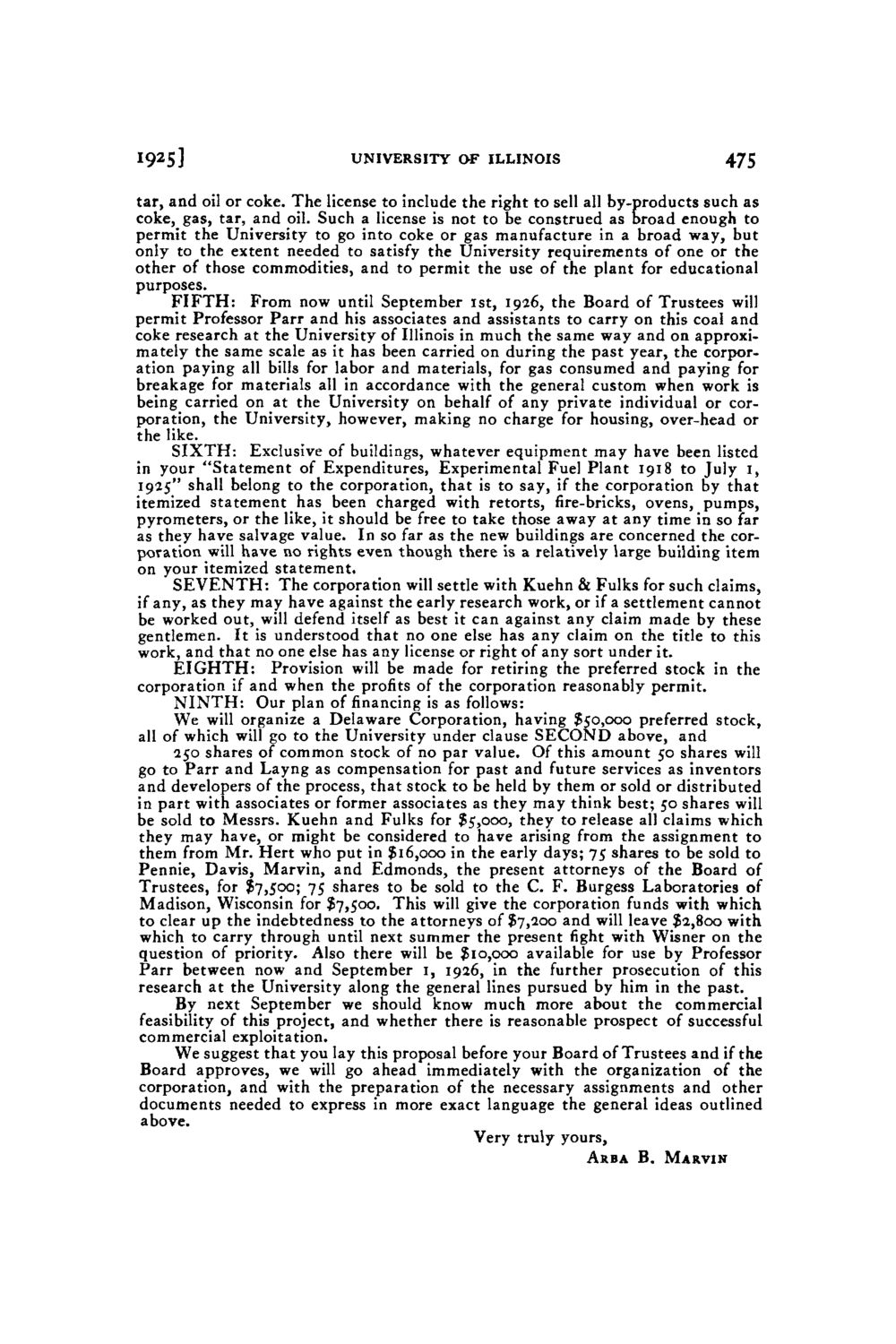| |
| |
Caption: Board of Trustees Minutes - 1926
This is a reduced-resolution page image for fast online browsing.

EXTRACTED TEXT FROM PAGE:
1925] UNIVERSITY O F ILLINOIS 475 tar, and oil or coke. The license to include the right to sell all by-products such as coke, gas, tar, and oil. Such a license is not to be construed as broad enough to permit the University to go into coke or gas manufacture in a broad way, but only to the extent needed to satisfy the University requirements of one or the other of those commodities, and to permit the use of the plant for educational purposes. F I F T H : From now until September 1st, 1926, the Board of Trustees will permit Professor Parr and his associates and assistants to carry on this coal and coke research at the University of Illinois in much the same way and on approximately the same scale as it has been carried on during the past year, the corporation paying all bills for labor and materials, for gas consumed and paying for breakage for materials all in accordance with the general custom when work is being carried on at the University on behalf of any private individual or corporation, the University, however, making no charge for housing, over-head or the like. S I X T H : Exclusive of buildings, whatever equipment m a y have been listed in your "Statement of Expenditures, Experimental Fuel Plant 1918 to July 1, 1925" shall belong to the corporation, that is to say, if the corporation by that itemized statement has been charged with retorts,fire-bricks,ovens, pumps, pyrometers, or the like, it should be free to take those away at any time in so far as they have salvage value. In so far as the new buildings are concerned the corporation will have norightseven though there is a relatively large building item on your itemized statement. S E V E N T H : The corporation will settle with Kuehn & Fulks for such claims, if any, as they m a y have against the early research work, or if a settlement cannot be worked out, will defend itself as best it can against any claim made by these gentlemen. It is understood that no one else has any claim on the title to this work, and that no one else has any license or right of any sort under it. E I G H T H : Provision will be made for retiring the preferred stock in the corporation if and when the profits of the corporation reasonably permit. N I N T H : Our plan offinancingis as follows: W e will organize a Delaware Corporation, having $50,000 preferred stock, all of which will go to the University under clause S E C O N D above, and 250 shares of c o m m o n stock of no par value. Of this amount 50 shares will go to Parr and Layng as compensation for past and future services as inventors and developers of the process, that stock to be held by them or sold or distributed in part with associates or former associates as they m a y think best; 50 shares will be sold to Messrs. Kuehn and Fulks for $5,000, they to release all claims which they m a y have, or might be considered to have arising from the assignment to them from M r . Hert who put in $16,000 in the early days; 75 shares to be sold to Pennie, Davis, Marvin, and Edmonds, the present attorneys of the Board of Trustees, for $7,500; 75 shares to be sold to the C. F. Burgess Laboratories of Madison, Wisconsin for $7,500. This will give the corporation funds with which to clear up the indebtedness to the attorneys of $7,200 and will leave $2,800 with which to carry through until next summer the present fight with Wisner on the question of priority. Also there will be $10,000 availableforuse by Professor Parr between now and September 1, 1926, in the further prosecution of this research at the University along the general lines pursued by him in the past. By next September w e should know much more about the commercial feasibility of this project, and whether there is reasonable prospect of successful commercial exploitation. W e suggest that you lay this proposal before your Board of Trustees and if the Board approves, w e will go ahead immediately with the organization of the corporation, and with the preparation of the necessary assignments and other documents needed to express in more exact language yours, B.ideas outlined general Marvin above. Very truly theArba
| |